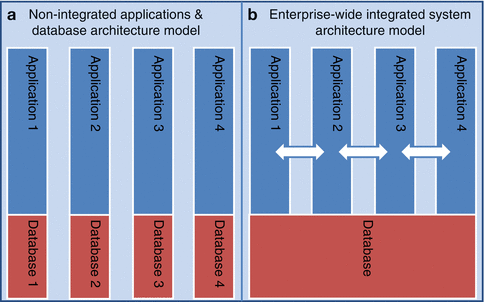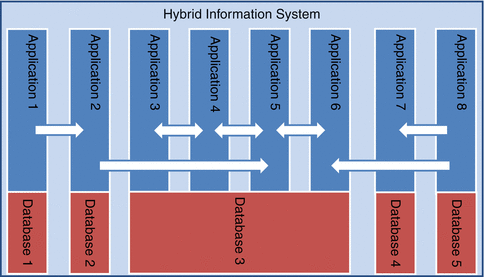Fig. 31.1
Components of a clinical information system with the electronic medical record as the core component that communicates with internal and external systems
Clinical activities or specialty areas may need to customize systems to perform specific functions not attainable within the broader system architecture. Specialty notes documentation, disease-specific tracking and management, order entry, and medication processing may be supported in this way. Health organizations that have been early adopters of CISs have typically done so using department or group-specific information systems, many of which were locally created. Computerized order entry and decision-support systems are such examples [19].
Knowledge-based reference systems, such as medication formularies and other online reference tools, are readily accessed through the Internet and have become strongly embedded in the day-to-day care of patients across all clinical settings. The electronic medical record (EMR) and the electronic health record (EHR) represent, perhaps, the most inclusive of the CIS types. The designation “EMR” generally refers to the collection of medical information related to a specific event or encounter in a single organization and usually sits at the center of the CIS structure in a healthcare organization (Fig. 31.1). The EHR refers to the repository of patient information collected over time and across organizations. Both hold the same health information contained in the paper-based medical record and are the product of the push for universal conversion to useful health information solutions.
Some of the forces driving this transition towards greater health IT adoption include advances in computer and information technology, a desire to reduce costs while enhancing efficiency, government and societal policy initiatives [6, 7], and the growing focus on patient safety, quality of care, and public health. The Institute of Medicine has stipulated, in its report from the Committee on Data Standards for Patient Safety, that the EMR and EHR should include the following core functions: collection of health information and data (data repository), results management, medication order entry, clinical decision support, communication capability among care providers and with the patient, administrative process support, patient support, and population health management and reporting [20]. Traditionally paper-based medical record systems, which are often highly fragmented both within and across hospital departments, continue to evolve into more accessible and integrated electronic clinical and administrative information systems [21].
Information Systems Architecture
An institution’s information systems architecture is guided by its values, IT goals, and requirements for the system. The architecture will, in turn, reflect the capabilities and features of the system, which are enabled by the specific core technologies, applications software, and desired workflow characteristics built into it. Several factors influence the construction and implementation of a system, including (1) the potential return on investment; (2) the financial, personnel, expertise, and existing IT infrastructure resources needed to acquire, implement, and develop the system; (3) the extent of customization efforts; and (4) the desired or expected workflows. The impact on workflow most directly affects the end users or clinical staff who expect that the system will enhance their ability to perform their duties, not hinder it, especially in the era of increased regulatory oversight and focus on care quality and safety outcomes.
The most common hospital IS approaches specifically related to the use of IT for clinical care across an institution are the integrated enterprise-wide system approach (using a single-vendor application software package); the multiple, non-integrated applications system approach, and a hybrid strategy (Figs. 31.2 and 31.3).



Fig. 31.2
Clinical information system architecture models. (a) The non-integrated model consists of separate applications and databases that are not integrated. (b) The integrated enterprise-wide model in which applications are integrated and rest on a common database

Fig. 31.3
A hybrid information system architecture model. Applications 3 through 6 and Database 3 are fully integrated. The other applications and their respective databases are separate except for variable, unidirectional integration at the application level
The Multiple, Non-integrated Applications Approach
An organization seeking to achieve multiple IS goals through the use of specialized, industry-established, customizable application system components may create what has been traditionally referred to as a best-of-breed system. Best-of-breed systems are comprised of core components, thought to be the best in the industry, that support departmental or group-specific workflow and software needs. They are also referred to as “stovepipe” systems, a term reflecting the parallel, non-integrated nature of their component systems in many circumstances (Fig. 31.2). Important advantages are that departments or specialty groups can select the best, usually most mature and customizable components, to achieve multiple IS goals within a single institution. Important disadvantages include limited ability to share data across applications. Interface engines and middleware software applications may be inserted to create interfaces between separate application systems, but these fixes are labor-intensive and costly. They are more typical in organizations that adopted IT early and in larger institutions with greater departmental diversity and specialization.
The Enterprise-Wide Integrated System Approach
Another organizational perspective that determines system architecture relates to the degree of application software or IS integration. With respect to IS integration, there are four domains of integration that are usually considered by the organization: organizational level integration, strategic integration, systems integration, and technical level integration. A high level of integration across these domains, particularly in relation to core application systems and technologies may be achieved by employing a single vendor application system and is generally referred to as the integrated enterprise-wide system approach. Such an approach has been valued in business, and greater integration across the healthcare enterprise has become a highly desired feature of contemporary healthcare information systems as indicated by studies of health IT management strategy [22–24].
Selected characteristics of the best-of-breed and integrated enterprise-wide system approaches, including key benefits and advantages related to implementation and usability are displayed in Table 31.1 [25]. Hybrid system architecture represents a third approach and will be discussed later in the chapter. Yet another method of achieving integration, though at the application level, involves the creation of a common user interface (using a separate, web-based application) to provide front-end access to multiple, otherwise separate applications. This is referred to as visual integration, which can be achieved, relatively superficially, with little disruption to the overall system infrastructure, albeit with limited functional characteristics.
Table 31.1
Selected characteristics of multiple, non-integrated applications and integrated enterprise-wide electronic information systems
Multiple, non-integrated applications system | Integrated enterprise-wide system | |||
|---|---|---|---|---|
Functionality | Multiple software applications | + | Single vendor applications | + |
Specialty-focused | + | Organization-focused | − | |
Applications more mature | + | Limited application maturity | − | |
Some now have clinical area/specialty focused modules | + | |||
Design | Highly customizable | + | Limited customization | − |
Variable or no integration | − | Highly integrated | + | |
Less standardization | − | Highly standardized | + < div class='tao-gold-member'>
Only gold members can continue reading. Log In or Register to continue
Stay updated, free articles. Join our Telegram channel
Full access? Get Clinical Tree
 Get Clinical Tree app for offline access
Get Clinical Tree app for offline access

| |